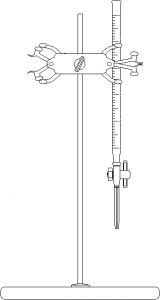Besides mass measurements, bureting/pipetting are the other techniques that you will frequently be doing in the laboratory. A titration is the gradual addition of a known volume of one reagent (the titrant) to another reactant until the observed completion of a chemical reaction. Typically, an indicator is employed to signal the complete consumption of the reactant in the flask. A proper titration allows an individual to determine when a stoichiometric amount of the two reagents has reacted.

A buret mounted on a clamp
Volume measurements in a titration are done using a buret. A buret is a precisely manufactured glass tube with graduations that allow volume of liquid delivered through a stopcock to be precisely measured. The 50.0 mL Class A buret used in the laboratory has been certified to deliver volumes to a tolerance of 0.1% of the total volume or in our case ±0.05 mL. The calibrated volume is valid only if the glassware is scrupulously clean because only a clean surface will support a uniform film of liquid need for accurate delivery. Breaks in this film, for example the formation of droplets on the inner surface, are an indication of dirty glassware. If liquid does not drain evenly down the wall of the, it needs to be cleaned. Calibrated glassware may be cleaned with a warm detergent solution (Alconox, use only detergents designed to clean glassware because they are designed not to leave a film on the glass). After the glassware is cleaned, it should be rinsed thoroughly with distilled water.
Reading the liquid level in a buret is a straight forward task. The bottom of the meniscus is normally read. Reading is aided by a white card – containing a dark area – placed in back of the meniscus. When the card is held so that the white part is above the meniscus and the darkened portion is slightly below the meniscus, the meniscus will appear darkened and easier to observe. Your eye must be level with the meniscus to avoid parallax error. If viewed from above, the reading will appear lower, whereas, if viewed from below, it will appear higher. For our burets with a 0.1 mL graduation you should read to ±0.05 mL. Because this last digit falls between the divisions it will have to be estimated but with practice you should be able to do this quite accurately.
Sources of error in buret use:
- a dirty buret that does not drain evenly
- an air bubble in the stopcock of buret tip
- parallax errors
- delivering the liquid too rapidly so that liquid on the side does not have time to drain
- not reading the buret properly
- Add 5 to 10 mL of the titrant, rotating to wet the interior completely, then drain. Repeat.
- Make sure the buret is clamped in a perfectly vertical position.
- Fill the buret to above the zero mark and drain some solution to free the buret tip of bubbles.
- Drain the solution to the zero mark and record the starting reading after 1 min. You don’t have to be at precisely zero but you do have to precisely record the initial reading.
- With the tip well within the titration vessel, begin draining the buret solution into the stirred sample, slowing the rate of addition to a drop at a time near the endpoint of the titration.
- When the endpoint is reached, rinse the tip off into the vessel, rinse the sides of the vessel, then wait 30 seconds and record to ±0.05 mL.
To deliver volume increments smaller than a normal drop (±0.03 mL) allow a partial drop to form and then rinse the partial drop into the titration. When delivering solutions, you should not allow the solution to drain below the bottom of the calibration range. It is best to design your titration so that no more than 45 mL is needed but if it does look like you will run past the bottom, close the stopcock and record the reading. Refill the buret, get an initial zero reading, and continue delivering the solution. The total volume delivered will be the volume delivered before refilling plus the volume delivered after refilling.
Here is a video about the proper use of burets:
